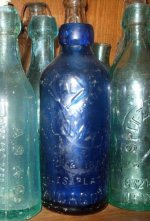jadocs
Forum Supporter
- Joined
- Jun 12, 2016
- Messages
- 688
Thought I would share this here. A few weeks ago I was relic hunting and dug up this bottle 6" down.
I don't know anything about bottles and certainly didn't know anything about this particular one. After some research and contacting the folks at Hutchbook.com I found out it was pretty rare.
Warwick Bottling Works, Newport News VA
Here she is fresh out of the ground:

Here she is cleaned up:


Here is what is listed on Hutchbook about it:

Turns out the number of these bottles are less than 10 known.

And here is Hutchbooks response to my email which told me more about it. Now I'm looking for bottles everywhere I go!
I don't know anything about bottles and certainly didn't know anything about this particular one. After some research and contacting the folks at Hutchbook.com I found out it was pretty rare.
Warwick Bottling Works, Newport News VA
Here she is fresh out of the ground:

Here she is cleaned up:


Here is what is listed on Hutchbook about it:

Turns out the number of these bottles are less than 10 known.

And here is Hutchbooks response to my email which told me more about it. Now I'm looking for bottles everywhere I go!
Nice find!
The bottle you found actually DOES match the one we have catalogued as VA0074. The natural color of glass is aqua (pale green). In order to turn it different colors, various types of additives are added to the mixture, e.g. adding gold will turn it red (that's why red glass is expensive). The owner(s) of Warwick Bottling Works paid the glass manufacturer extra in order to have their bottles blown with clear glass, likley hoping that doing so would make the contents appear to be more appealing to customers. The additive the manufacturer of VA0074 used to turn the glass mixture clear was manganese. Ultra-violet light (e.g. the sun's rays) will turn clear glass various shades of amethyst, depending on how much manganese was in the glass mixture. The use of manganese as an additive was curtailed due to WWI and an increased demand for manganese to manufacture munitions. Even though your bottle was likely buried in the ground for well over 100 years, it has been exposed to UV rays because they penetrate the earth and react with the manganese in the glass. VA0074 is catalogued as "clear" because that was the original glass color at the time the bottle was manufactured.
Yes, the "R" in the listing means the bottle's rarity rating is "Rare" (position your cursor over the "R" and a pop-up will appear spelling out "Rare"). The rarity definitions we are using for HutchBook.com are spelled out in the "Hutchinson Data Definitions" portion of the "Hutchinson Directory" page.
We have no historical information about this bottling plant in file and aren't aware of any published books providing information about Virginia soda bottlers or their bottles. The public library and/or a historical society in Newport News should be able to help you find information about the years the bottling plant was in operation, its location, the ownership, etc. A related variant of your bottle is VA0073. That bottle included the owner's name - N. D. Pitman. No doubt the "P (in diamond)" embossed on VA0074 was Pitman's trade mark.
Continued success with your detecting!
Ron F.
[email protected]
HutchBook.com


